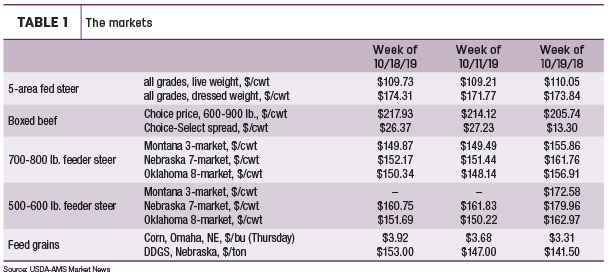The purpose of this article is not just to discuss the export data from this report, but also to discuss an important but complex factor that impacts trade: the value of the U.S. dollar.
To the ERS report first: Beef exports were lower in August 2019 as compared to July 2019 and also to August 2018. For January-August, beef exports were 3.8% lower than in the same period of 2018. Exports to Japan, the top U.S. beef export destination, were down 8.6% during this time period. Exports to South Korea were up 8%. Together, these two countries accounted for 50.5% of U.S. beef exports during data available for 2019. The October USDA World Agricultural Supply and Demand Estimates (WASDE) report lowered the 2019 projection for beef exports to 3.126 billion pounds, which would be about a 1% decline compared to 2018.
Now, let’s shift focus to the value of the U.S. dollar. For many of us, we might first think about inflation or the thought “a dollar isn’t worth what it used to be.” This is of course true, but is not exactly the type of value to consider when viewing things in the context of trade with other countries. More specifically, we are considering exchange rates or value of the U.S. dollar in another country. When customers in other countries want to purchase U.S. beef, an exchange of their currency with U.S. dollars must occur at some point. The value of the U.S. dollar versus the foreign currency is the exchange rate, and fluctuations in this rate can make beef more (or less) expensive to the importer. Exchange rates fluctuate frequently between foreign currencies and are actively traded in foreign exchange (or Forex) markets.

Let’s consider a simplified U.S. beef exported to Japan example for illustration. Let’s assume the exchange rate for one U.S. dollar is 100 Japanese yen. Also, assume that a customer in Japan wants to import 1,000 pounds of U.S. beef, and the price of that beef is 5 U.S. dollars (USD) per pound. At the current exchange rate, the customer in Japan would pay 500,000 yen for this transaction (1,000 pounds x 5 USD x 100 yen). Now assume that a month later, the exchange rate for one U.S. dollar is 102 Japanese yen. This would be considered a stronger U.S. dollar relative to the yen because it costs more yen to buy the same dollar. Even if the price of beef in U.S. dollars is still 5 USD per pound, the customer in Japan would now pay 510,000 yen for this transaction (1,000 pounds x 5 USD x 102 yen).
Thus, the example of a 2% increase in the exchange rate (from 100 to 102) led to a 2% increase in the cost to the customer in Japan. This is why a strong U.S. dollar can sometimes be described as a headwind to U.S. beef exports. The flip side is a stronger dollar makes goods imported into the U.S. relatively cheaper.
Foreign exchange markets and their impact on trade are very complex, to say the least. The above example does not consider that the exchange rates between other beef exporting countries (e.g., Australia) and key beef importers (e.g., Japan) are also constantly changing. Fluctuating exchange rates could make it cheaper for the customer in Japan to import U.S. beef one month and Australian beef the next month even if the price of beef in those countries doesn’t change. We know that prices change frequently within countries, countries face different tariff structures and exchange rates are constantly changing – and this doesn’t even consider the cost of transporting the beef. Put simply, there are a lot of moving parts.
The U.S. dollar is relatively strong right now, and this is likely one of the contributing factors to the slightly lower exports shown in the ERS report. Compared to the Australian dollar, the U.S. dollar averaged about 8% stronger during January-September 2019 than during the same period of 2018. It was also stronger than 2018 levels for comparisons against the Canadian dollar, the euro and the Mexican peso. Contrary to the example used above, the U.S. dollar has been about the same or slightly weaker relative to the Japanese yen compared to a year ago, which would imply U.S. beef is slightly cheaper to customers in Japan if everything else remained constant. But everything has not remained constant, and the exchange rates between Japan and other beef exporting countries have also changed. While exchange rates are just one factor in the beef trade complex, they can have important implications on the flow of beef around the world. ![]()
—This originally appeared in the In the Cattle Markets newsletter, Oct. 21, 2019

-
Josh Maples
- Assistant Professor and Extension Economist
- Department of Agricultural Economics
- Mississippi State University








